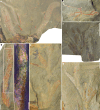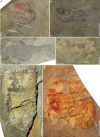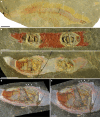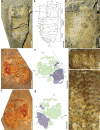The Cabrières Biota (France) provides insights into Ordovician polar ecosystems
- PMID: 38337049
- PMCID: PMC11009115
- DOI: 10.1038/s41559-024-02331-w
The Cabrières Biota (France) provides insights into Ordovician polar ecosystems
Abstract
Early Palaeozoic sites with soft-tissue preservation are predominantly found in Cambrian rocks and tend to capture past tropical and temperate ecosystems. In this study, we describe the diversity and preservation of the Cabrières Biota, a newly discovered Early Ordovician Lagerstätte from Montagne Noire, southern France. The Cabrières Biota showcases a diverse polar assemblage of both biomineralized and soft-bodied organisms predominantly preserved in iron oxides. Echinoderms are extremely scarce, while sponges and algae are abundantly represented. Non-biomineralized arthropod fragments are also preserved, along with faunal elements reminiscent of Cambrian Burgess Shale-type ecosystems, such as armoured lobopodians. The taxonomic diversity observed in the Cabrières Biota mixes Early Ordovician Lagerstätten taxa with Cambrian forms. By potentially being the closest Lagerstätte to the South Pole, the Cabrières Biota probably served as a biotic refuge amid the high-water temperatures of the Early Ordovician, and shows comparable ecological structuring to modern polar communities.
© 2024. The Author(s).
Conflict of interest statement
The authors declare no competing interests.
Figures
















References
-
- Seilacher, A., Reif, W. E. & Westphal, F. Sedimentological, ecological and temporal patterns of fossil Lagerstätten. Philos. Trans. R. Soc. Lond. B311, 5–24 (1985).
-
- Allison, P. A. & Briggs, D. E. Exceptional fossil record: distribution of soft-tissue preservation through the Phanerozoic. Geology21, 527–530 (1993).
-
- Brasier, M. D., Antcliffe, J. B. & Callow, R. H. T. in Taphonomy: Process and Bias Through Time 2nd edn, Vol. 32 (eds P. A. Allison & D. J. Bottjer) Ch. 15, 519–567 (Springer Science, 2011).
-
- Muscente, A. D. et al. Exceptionally preserved fossil assemblages through geologic time and space. Gondwana Res.48, 164–188 (2017).
-
- Van Roy, P. et al. Ordovician faunas of Burgess Shale type. Nature465, 215–218 (2010). - PubMed
MeSH terms
Grants and funding
- PZ00P2_209102/Schweizerischer Nationalfonds zur Förderung der Wissenschaftlichen Forschung (Swiss National Science Foundation)
- 205321_179084/Schweizerischer Nationalfonds zur Förderung der Wissenschaftlichen Forschung (Swiss National Science Foundation)
- PZ00P2_193520/Schweizerischer Nationalfonds zur Förderung der Wissenschaftlichen Forschung (Swiss National Science Foundation)
- CRSII5_198691/Schweizerischer Nationalfonds zur Förderung der Wissenschaftlichen Forschung (Swiss National Science Foundation)
LinkOut - more resources
Full Text Sources
Miscellaneous

